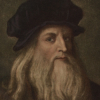Leonardo da Vinci

Leonardo da Vinci
Leonardo di ser Piero da Vinci, more commonly Leonardo da Vinci or simply Leonardoˈvintʃi] ; 15 April 1452 – 2 May 1519), was an Italian polymath whose areas of interest included invention, painting, sculpting, architecture, science, music, mathematics, engineering, literature, anatomy, geology, astronomy, botany, writing, history, and cartography. He has been variously called the father of paleontology, ichnology, and architecture, and is widely considered one of the greatest painters of all time. Sometimes credited with the inventions of the parachute, helicopter and tank,...
NationalityItalian
ProfessionPainter
Date of Birth15 April 1452
CityVinci, Italy
CountryItaly
Threats alone, are the weapons of the threatened man.
Those who are inspired by a model other than Nature, labor in vain.
The painter who draws merely by practice and by eye, without any reason, is like a mirror which copies every thing placed in front of it without being conscious of their existence.
Happy will they be who lend ear to the words of the dead.
When taking a selfie, remember the most natural pose is still best
Nothing is hidden under the sun.
We know more about the movement of celestial bodies than about the soil underfoot.
The eye is the window of the human body through which it feels its way and enjoys the beauty of the world.
Medicine is the restoration of discordant elements.
Here is a thing which the more it is needed the more it is rejected: and this is advice, which is unwillingly heeded by those who most need it, that is to say, by the ignorant.
Ask advice of him who governs himself well.
A single and distinct luminous body causes stronger relief in the objects than a diffused light; as may be seen by comparing one side of a landscape illuminated by the sun, and one overshadowed by clouds, and illuminated only by the diffused light of the atmosphere.
Now do you not see that the eye embraces the beauty of the whole world? It counsels and corrects all the arts of mankind... it is the prince of mathematics, and the sciences founded on it are absolutely certain. It has measured the distances and sizes of the stars it has discovered the elements and their location... it has given birth to architecture and to perspective and to the divine art of painting.
Who would believe that so small a space could contain the images of all the universe?